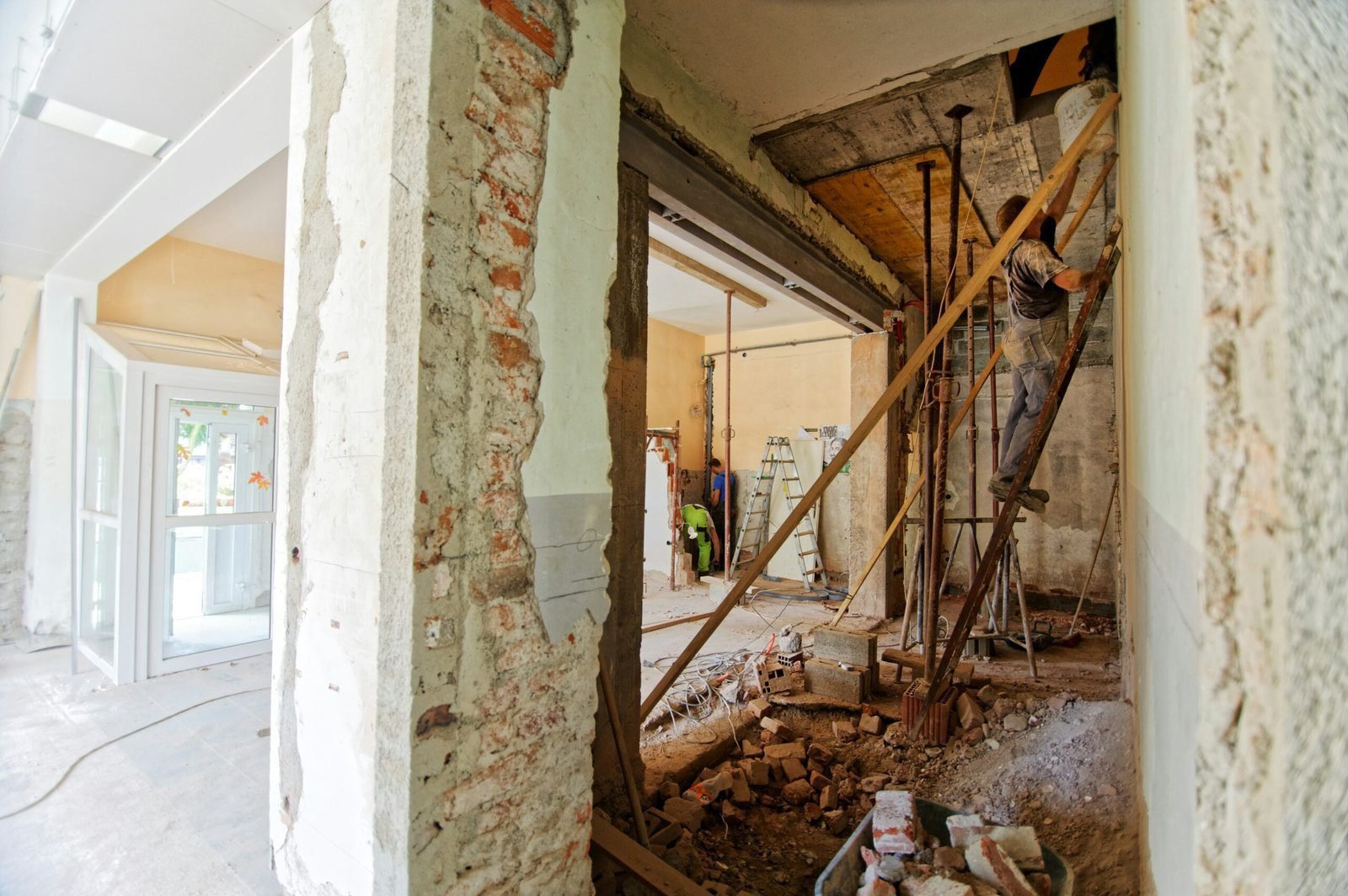Renovation vs. Remodel
Renovation and remodel are two terms that are often used interchangeably, but they actually refer to different types of home improvement projects. Understanding the distinction between the two can help you determine the scope of your project and set realistic expectations.
A renovation typically involves restoring or repairing an existing structure or space. It focuses on updating the aesthetics and functionality of a room or area without making any major structural changes. For example, if you have a dated kitchen with worn-out cabinets and countertops, a renovation might involve replacing those elements with new ones to give the space a fresh look. Renovations can also include refinishing floors, repainting walls, or installing new fixtures.

On the other hand, a remodel involves making significant changes to the structure or layout of a space. This type of project often requires professional assistance from architects, contractors, and engineers. A remodel might involve tearing down walls to create an open-concept living area, adding an extension to increase square footage, or completely reconfiguring the layout of a room. Remodels are more complex and time-consuming than renovations, as they often require permits and involve extensive construction work.
Deciding between a renovation
When deciding between a renovation and a remodel, it’s important to consider your goals, budget, and timeline. Renovations are generally more cost-effective and less disruptive, as they involve cosmetic changes that can be completed relatively quickly. Remodels, on the other hand, can be more expensive and time-consuming, but they offer the opportunity to completely transform a space and customize it to your specific needs.
Before starting any home improvement project, it’s crucial to do your research, set a realistic budget, and consult with professionals to ensure that your vision aligns with what is feasible. Whether you choose to renovate or remodel, investing in your home can not only improve its functionality and aesthetics but also increase its value.
Remodeling your home is an exciting and transformative process that allows you to customize your living space to your exact specifications. Whether you want to update an outdated kitchen, create a luxurious master suite, or add a home office, a remodel can help you achieve your vision.
Benefits of remodeling
One of the key benefits of remodeling is the ability to alter the structure and layout of your home. This means you can reconfigure rooms, remove walls to create an open floor plan, or add new rooms altogether. With the help of architects and contractors, you can turn your current space into a functional and beautiful home that suits your lifestyle.
Not only does remodeling offer the opportunity to improve the aesthetics and functionality of your home, but it can also increase its value. By investing in high-quality materials and finishes, you can create a space that stands the test of time and appeals to potential buyers if you ever decide to sell your home.
However, it’s important to note that remodeling projects can be complex and require careful planning and execution. From obtaining necessary permits to coordinating various tradespeople, there are many factors to consider. That’s why it’s crucial to work with experienced professionals who can guide you through the process and ensure everything is done correctly.
Remodeling can be a time-consuming and costly endeavor
Furthermore, remodeling can be a time-consuming and costly endeavor. Depending on the scope of the project, it may take weeks or even months to complete. It’s essential to have a clear budget and timeline in place before starting the remodel to avoid unexpected expenses and delays.
Despite the challenges, remodeling your home can be a rewarding experience that allows you to create a space that reflects your personal style and meets your specific needs. Whether you’re looking to update a single room or transform your entire home, a remodel can breathe new life into your living space and enhance your overall quality of life.
Please, read our post and do not forget to check our YouTube channel “Grig Stamate”:
https://www.youtube.com/@GrigStamate
You will find there, thousands of designing, furnishing, and decorating ideas for your home interior and outdoors.
Allow me to mention one of them:
Remodel Your Kitchen with These Creative Ideas | Interior Design Ideas #4 (video)
Deciding between a renovation and a remodel
When deciding between a renovation and a remodel, it’s crucial to take into account the scope of changes you want to make. If you’re looking to update the look of your home without undertaking major structural changes, a renovation might be the perfect choice for you. Renovations can be done on a smaller scale, focusing on specific areas or rooms that need improvement.
For example, if your kitchen is outdated and in need of a facelift, a renovation can involve replacing countertops, cabinets, and appliances to give it a fresh and modern look. Similarly, if your bathroom is in desperate need of an upgrade, a renovation can involve replacing fixtures, tiles, and adding new storage options to enhance its functionality and aesthetics.
Renovations are often more budget-friendly than remodels since they involve making cosmetic changes rather than structural alterations. You can choose to tackle one room at a time, gradually improving your home’s overall appearance while staying within your budget constraints.
On the other hand, if you have a specific vision in mind and are willing to invest more time and money, a remodel might be the better option. Remodeling allows for more extensive customization and can address functional issues that a renovation might not be able to solve.
For instance, if you want to completely transform your outdated and cramped kitchen into a spacious and open-concept cooking area, a remodel can involve knocking down walls, rearranging the layout, and installing new plumbing and electrical systems. This level of customization and structural changes is typically not possible with a renovation.
Remodeling projects often require a larger budget and a longer timeline to complete. They may also disrupt your daily life more significantly, as they involve more extensive construction and potentially require you to temporarily move out of your home. However, the end result can be a truly personalized and functional space that perfectly suits your needs and preferences.
Ultimately, the decision between a renovation and a remodel depends on your goals, budget, and the extent of changes you want to make. It’s important to carefully consider these factors and weigh them against your specific needs and preferences before making a final decision.
DIY home remodeling
Another important factor to consider when deciding whether to do DIY home remodeling is your budget. While DIY projects can save you money on labor costs, you still need to account for the cost of materials and tools. Depending on the scope of the project, these expenses can add up quickly.
It’s also worth considering the potential risks involved in DIY remodeling. If you’re not experienced in construction or renovation work, you may not be aware of the safety precautions and building codes that need to be followed. This could lead to accidents or violations that could be costly to fix.
Furthermore, DIY remodeling projects can be time-consuming, especially if you have other commitments like work or family responsibilities. It’s important to realistically assess how much time you can dedicate to the project and whether it will disrupt your daily life.
Hiring professionals for your home remodeling project
On the other hand, hiring professionals for your home remodeling project has its benefits. They have the expertise and experience to handle the job efficiently and effectively. They also have access to a network of suppliers and subcontractors, which can save you time and ensure that the project is completed on schedule.
Additionally, professionals are familiar with the latest trends and technologies in home remodeling. They can offer valuable advice and suggestions to enhance the functionality and aesthetics of your space. They can also help you navigate any legal or permit requirements that may be necessary for your project.
Ultimately, the decision to do DIY home remodeling or hire professionals depends on your skills, resources, and personal preferences. It’s important to weigh the pros and cons carefully and consider the specific requirements of your project. Consulting with professionals can help you make an informed decision and ensure that your home remodeling project is a success.
Renovating Old Homes: Tips and Considerations
Renovating an old home can be a labor of love. It’s an opportunity to restore its original charm while incorporating modern conveniences. However, renovating an old home comes with its own set of challenges and considerations.
Here are a few tips to keep in mind when renovating an old home:
- Preserve the character: Old homes often have unique architectural features and historical significance. Whenever possible, try to preserve these elements and incorporate them into your renovation plans. For example, if your home has original crown molding or decorative plasterwork, consider restoring it rather than replacing it with a modern alternative. Not only will this maintain the authenticity of the home, but it can also add value and charm.
- Upgrade the essentials: Old homes may have outdated electrical, plumbing, or HVAC systems. It’s important to prioritize these upgrades to ensure the safety and comfort of your home. When working with professionals, such as electricians or plumbers, ensure that they have experience working with older homes. They will understand the unique challenges that can arise and will be able to provide appropriate solutions.
- Consider energy efficiency: Older homes tend to be less energy-efficient. Look for ways to improve insulation, install energy-efficient windows, and upgrade appliances to reduce your carbon footprint and save on utility bills. Consider adding insulation to the attic or walls, sealing any drafts, and installing a programmable thermostat to regulate the temperature more efficiently.
- Work with professionals: Renovating an old home can be complex, especially if you’re dealing with structural issues or historical preservation requirements. Consult with architects, contractors, and other experts to ensure that your renovation is done right. They can help you navigate any necessary permits or approvals and provide guidance on how to best preserve the historical integrity of the home while making necessary upgrades.
- Plan for surprises: When renovating an old home, it’s almost inevitable to encounter unexpected surprises along the way. Set aside a contingency budget and be prepared to adapt your plans as needed. For example, you may uncover hidden structural damage or discover that certain materials are no longer available. Being flexible and having a backup plan will help you navigate these challenges without derailing your renovation project.
Renovating an old home can be a fulfilling experience, but it requires careful planning, patience, and a willingness to embrace the unique challenges that come with restoring a piece of history. By following these tips and working with professionals, you can successfully renovate an old home and create a space that seamlessly blends the past with the present.
Common Remodeling Mistakes to Avoid
Embarking on a remodeling project can be exciting, but it’s important to avoid common pitfalls that can turn your dream project into a nightmare. Here are some common remodeling mistakes to avoid:
- Not setting a realistic budget: It’s essential to establish a budget before starting any remodeling project. Be realistic about your financial limitations and plan accordingly. Consider factors such as material costs, labor expenses, and unexpected contingencies. By setting a realistic budget, you can ensure that you have enough funds to complete the project without compromising on quality or cutting corners.
- Skipping the planning phase: Rushing into a remodel without proper planning can lead to costly mistakes and delays. Take the time to create a detailed plan and consider all aspects of the project. This includes determining the scope of work, creating a timeline, and researching the necessary materials and contractors. Planning ahead will help you anticipate any challenges that may arise and allow you to make informed decisions throughout the remodeling process.
- Ignoring permits and regulations: Depending on the scope of your remodel, you may need permits and approvals from local authorities. Failing to obtain the necessary permits can result in fines and legal issues. It’s crucial to familiarize yourself with the building codes and regulations in your area and ensure that your project complies with them. This may involve submitting plans, paying fees, and scheduling inspections. By following the proper procedures, you can avoid costly setbacks and ensure that your remodel is safe and up to code.
- Overlooking functionality: It’s easy to get caught up in the aesthetics of a remodel and overlook the functionality. While it’s important to create a visually appealing space, it’s equally important to ensure that it meets your practical needs. Consider factors such as traffic flow, storage space, and ease of use. For example, in a kitchen remodel, prioritize efficient work areas, ample storage, and durable materials. By focusing on functionality, you can create a space that not only looks great but also enhances your daily life.
- Choosing trendy over timeless: While it’s tempting to follow the latest design trends, they can quickly become outdated. Opt for timeless design elements that will stand the test of time. This doesn’t mean you have to sacrifice style or personalization. Instead, focus on incorporating classic elements that can be easily updated with accessories or minor changes. For example, choose neutral colors for larger surfaces like walls and floors, and add pops of color or trendy accents through easily replaceable items like throw pillows or artwork. By striking a balance between timeless and trendy, you can create a space that feels current and fresh while remaining timeless in its appeal.
By avoiding these common remodeling mistakes, you can ensure a smoother and more successful project that meets your expectations and adds value to your home. Remember, proper planning, budgeting, and attention to functionality and timeless design will go a long way in creating a remodel that you can enjoy for years to come.
Renovation Budget Tips: How to Make the Most of Your Money
One of the most important aspects of any home improvement project is setting and sticking to a budget. Here are some tips to help you make the most of your renovation budget:
- Prioritize your needs: Identify the most critical areas that require renovation and allocate your budget accordingly. Focus on essential repairs and upgrades before considering cosmetic changes. For example, if your roof is leaking or your plumbing needs fixing, addressing these issues should be your top priority.
- Get multiple quotes: When hiring professionals for your renovation, always obtain multiple quotes. This allows you to compare prices and choose the best option that fits within your budget. Additionally, don’t forget to check the credentials and references of the contractors to ensure they are reliable and trustworthy.
- Consider cost-effective alternatives: Look for ways to achieve the desired look or functionality without breaking the bank. For example, instead of replacing cabinets, you can opt for refinishing or repainting. Similarly, you can explore second-hand stores or online marketplaces for furniture and fixtures that are in good condition but at a lower cost.
- Shop around for materials: Don’t settle for the first option you come across. Take the time to shop around and compare prices for materials, fixtures, and appliances. You may find that different suppliers offer the same product at varying prices, allowing you to make significant savings without compromising on quality.
- Leave room for contingencies: It’s always a good idea to set aside a contingency budget for unexpected expenses or changes in the scope of the project. Renovations often uncover hidden issues that need immediate attention, such as mold or structural damage. Having a contingency fund will help you address these unforeseen circumstances without derailing your entire budget.
By following these budget tips, you can ensure that your renovation project stays on track financially and delivers the results you desire. Remember, careful planning, research, and flexibility are key to maximizing your budget and creating a home that is both beautiful and functional.
When it comes to home improvement, there are countless options to consider. From small upgrades like repainting a room or replacing outdated fixtures to larger projects like adding a new room or renovating an entire floor, the possibilities are endless. The key is to identify the areas of your home that could benefit from improvement and prioritize them based on your budget and timeline.
One popular home improvement project is kitchen remodeling. The kitchen is often considered the heart of the home, and a well-designed and functional kitchen can significantly enhance the overall value and appeal of a property. This type of renovation typically involves replacing old appliances, updating cabinets and countertops, and improving the layout and flow of the space.
Home improvement project
Bathroom renovations are also a common home improvement project. A modern and stylish bathroom can make a big difference in the overall feel of a home. This type of renovation may include replacing old fixtures, installing new flooring and tiles, and updating the plumbing and electrical systems.
Another area that homeowners often focus on when it comes to home improvement is the exterior of the house. Curb appeal is important, as it creates a positive first impression and can increase the value of the property. This can involve tasks such as landscaping, painting the exterior, replacing windows and doors, and adding outdoor living spaces like patios or decks.
Home improvement projects can also extend to energy efficiency upgrades. With the increasing focus on sustainability and reducing energy consumption, many homeowners are investing in projects that make their homes more environmentally friendly. This can include installing solar panels, upgrading insulation, replacing old appliances with energy-efficient ones, and implementing smart home technology.
CONCLUSION
Regardless of the specific project, home improvement is about creating a space that suits your lifestyle and preferences. It’s an opportunity to personalize your home and make it a reflection of your tastes and needs. Whether you’re tackling a small renovation or embarking on a major remodeling project, the end result should be a home that you love and enjoy for years to come.
Other related posts from our website:
https://howtobuildahouseblog.com/bathroom-remodeling-and-improvement-corner-bathtubs/
https://howtobuildahouseblog.com/remodeling-a-small-bedroom/
https://howtobuildahouseblog.com/the-best-bathroom-remodeling-tips/
Thank you so much for your attention.
Stay tuned. We will upload many other amazing posts to our website and videos onto our YouTube channel.
Thank you so much.
for your time and attention.
Best Regards
See you to another post,
Bye, Bye



No Responses